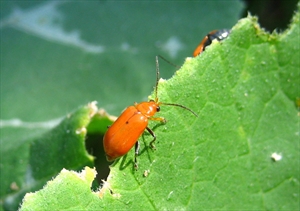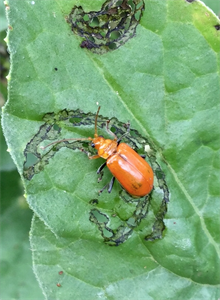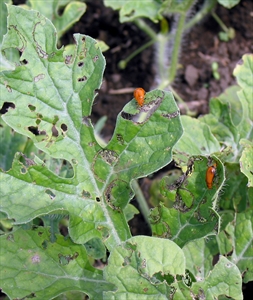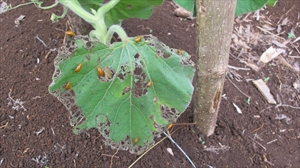Pumpkin beetle, red pumpkin beetle
Pacific Pests, Pathogens and Weeds - Online edition
Pacific Pests, Pathogens & Weeds
Pumpkin beetle (040)
Aulacophora species. The identification of the species in the Pacific is uncertain. Aulacophora similis has been recorded from Fiji, Samoa, Solomon Islands, and Tonga. But it is more likely that the species in these countries is Aulacophora abdominalis.
Uncertain. Asia, Oceania. A revision of the species is required to clarify distribution in Oceania and elsewhere.
Cucurbits are hosts; common cucurbits are cucumber, melon, pumpkin, watermelon and gourds. Similar species are pests of these plants in Papua New Guinea, Indonesia, the Philippines, Japan, India, and Australia.
The life cycle of Aulacophora similis is as follows. Females lay yellow, oval eggs singly or in batches in soil around the base of the host. After 5-15 days, they hatch, and the cream-white young (called 'larvae') burrow into the soil to feed primarily on the roots. Four moults occur over 14-25 days, and then the larvae enter the pupal stage in an earth chamber; this lasts another 7-20 days before the adults emerge (Photos 1-3).
Females lay up to 500 eggs, and live as long as 10 months. This means there are several overlapping generations each year.
Interestingly, the adult beetles cut discs from the leaves (Photos 2,4&5). It is possible they do this to stop the flow of sap into these discs before feeding on them. There may be substances in the sap which are toxic to the beetle.
Often, several beetles are found feeding together on the same leaf while others are untouched (Photo 6).
Adults feed on leaves, chewing large holes. Seedlings are particularly susceptible, and so are young plants after planting out. The damage to young plants can delay crop maturity. Damage also occurs to flowers and small fruit.
The larvae probably damage roots and stems, but evidence of this has not been reported from Pacific island countries. This type of damage may allow entry of other organisms, especially fungi.
Look for red oval beetles, about 8 mm long, on the leaves and flying between them. They are often in groups on both young and old leaves. Look for the circles eaten by the beetles, and the large holes in the leaves between the veins. Often, groups of beetles will attack the same leaf, leaving only the veins, before moving to other leaves. Adults are strong fliers, and quickly take to the wing when disturbed.
A similar coloured leaf beetle, Monolepta (now called Candesia), has a dark area on the triangular piece at the base of the wing cases. It also has a smooth thorax - the part behind the head. By contrast, Aulacophora has a groove across the thorax (this can be seen in Photo 3). (See Fact Sheet no. 53 - Monolepta.)
NATURAL ENEMIES
There is little known about the natural control of these beetles. The beetles contain chemicals that visual predators do not like, and are avoided by them. The bright colours of this beetle warn predators that they are distasteful.
RESISTANT VARIETIES
Fast growing varieties are more likely to outgrow the damage caused by the beetles.
CULTURAL CONTROL
Before planting:
- Avoid planting new crops next to those already infested with the beetles.
During growth:
- Provide conditions for healthy rapid plant growth, especially for seedlings; that may include manures and/or commercial fertilizers, and adequate water.
- The beetles tend to group together feeding on some plants, leaving others; plant extra seed to compensate for this.
- In the early morning or evening, it is possible to catch the beetles in flight; this is a useful control method in small gardens. Perhaps a game for children!
After harvest:
- Collect debris and burn or bury it.
- Do not plant new crops on the same land where outbreaks of the beetle occurred, or leave at least 1-2 months after harvest and the destruction of the remains of the last crop before planting a new crop.
CHEMICAL CONTROL
- Use wood ash. Add ½ cup of wood ash and ½ cup of lime in 4 L water; leave to stand for some hours and then strain; test on a few infested plants first to make adjustment to the strength before going into large-scale spraying.
- Use plant-derived products, such as neem, derris or pyrethrum (with the addition of soap).
- Note, a variety of Derris, brought many years ago to Solomon Islands from Papua New Guinea, is effective as a spray. It contains rotenone, an insecticide, so it should be used with caution. There may be varieties of Derris (fish poisons) in your country that can be tried (see Fact Sheet no. 56).
- Alternatively, synthetic pyrethroids are likely to be effective, but will also kill natural enemies.
____________________
When using a pesticide, always wear protective clothing and follow the instructions on the product label, such as dosage, timing of application, and pre-harvest interval. Recommendations will vary with the crop and system of cultivation. Expert advice on the most appropriate pesticide to use should always be sought from local agricultural authorities.
AUTHORS Helen Tsatsia & Grahame Jackson
Information from Chris Reid (pers.comm.). Australian Museum, Sydney; and from Aulacophora. Wikipedia. (http://dx.doi.org/10.1155/2016/3702789); Henderson RC, Crosby TK (2012) Pumpkin beetle (Aulacophora indica): PaDIL - http://www.padil.gov.gov.au. Photos 1&4 Graham Teakle, Canberra. Photos 2&3 Mani Mua, SPC, Sigatoka Research Station, Fiji.
Produced with support from the Australian Centre for International Agricultural Research under project PC/2010/090: Strengthening integrated crop management research in the Pacific Islands in support of sustainable intensification of high-value crop production, implemented by the University of Queensland and the Secretariat of the Pacific Community.









